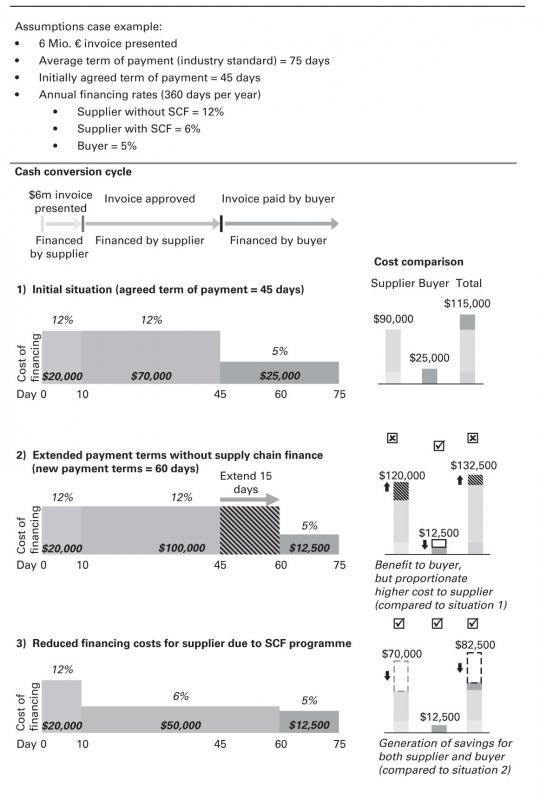The Basic Benefits of Supply Chain Finance

This is an exclusive extract from Financing the End-to-end Supply Chain.
Supply Chain Finance (SCF) solutions bring many benefits. For companies that have not yet implemented an SCF solution, the main reasons are reduction of net debt and the improvement of WCM processes. In particular, these include the standardization of payment objectives and improved information links with suppliers and/or customers. For companies that have already implemented an SCF solution, greater financing flexibility and the reduction of SC risks (particularly suppliers’ risk of default) are also significant perceived benefits.
We would like to present the economics of SCF within the following example, as illustrated in Figure 4.10 (according to Greensill, 2010). The example consists of a dyadic supply chain relationship with a smaller supplier and a large buying company (customer). As highlighted, the financing costs for the supplier, buyer and in total are based on a US $6 million invoice presented in three different situations:

In the initial situation 1, it is assumed that the buyer does not provide any financing activities to the supplier. Consequently, the supplier does not benefit from an SCF solution and thus has an annual financing rate of 12%. Additionally, the costs of financing are based on the initially agreed payment terms of 45 days.
In situation 2, the buyer decides to extend the payments vis-à-vis the supplier by 15 days. Thus, the supplier again does not benefit from an SCF solution. In contrast, the costs of financing are based on the average payment terms of 60 days (as an industry standard). This results in a longer DPO and lower cost of capital for the buyer but also a proportionately longer DSO and higher COC for the supplier. Even worse, from a broader SC perspective, the total costs for the SC rise, leading to a win–lose situation.
In situation 3, the supplier benefits from an SCF solution and thus has a new annual financing rate of 6%. The costs of financing are based on average payment terms of 60 days (industry standard), likewise. This results in the same COC for the buyer compared to situation 2 but in a lower COC for the supplier and thus in lower total costs for the SC. The potential financing cost reduction in this specific scenario is US $50,000. But with higher payment terms the financing cost savings are even greater. In practice, the current win–lose situation could be corrected by introducing an SCF solution to create a WWS.
Within the examples, the respective costs are calculated as follows:

In addition to the benefits highlighted in the example, the adoption and implementation of an SCF solution brings additional advantages. Additional benefits for the buying company are, for instance (Greensill, 2010):
- Their financial SC becomes more resilient as key suppliers have greater financial certainty and are therefore in a better position to fulfil orders on time, reducing risk in the buyer’s financial SC.
- The cost of processing is reduced as the number of supplier queries, in-house payment processes and payment fees are reduced.
- Relationships with suppliers are improved, with the potential to achieve better commercial terms without negatively impacting on suppliers.
- An SCF programme does not compromise a company’s ability to source other forms of financing and does not impact on its credit rating.
For the supplier, the benefits are comparable, for example:
- Cash flow is predictable, as invoices are settled on time by the buyer’s bank. WC requirements are therefore reduced and cash flow becomes less constrained. Suppliers may also be able to offer more competitive terms as the cost of late payment does not need to be factored into invoices.
- There is the option to seek early payment as a means of financing. This financing is effectively pre-approved and is not subject to the supplier’s financial standing. For companies that could not otherwise source financing, or where the cost would be prohibitive, this can be a major benefit. For those with alternative means of financing, credit lines are released for other purposes.
- Reconciliation, account posting and management reporting are enhanced as remittance information is provided in a format that can be integrated with internal systems.






